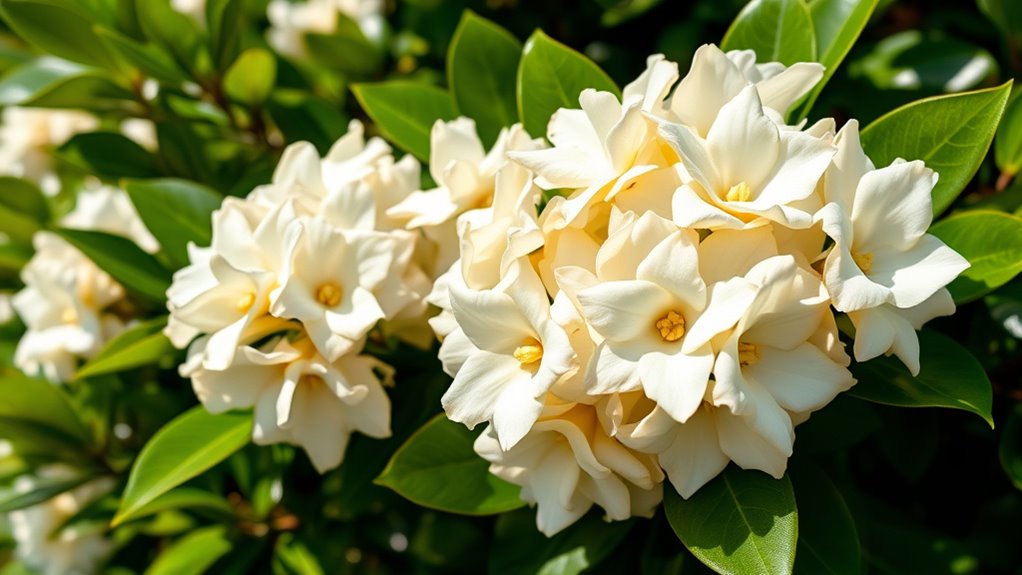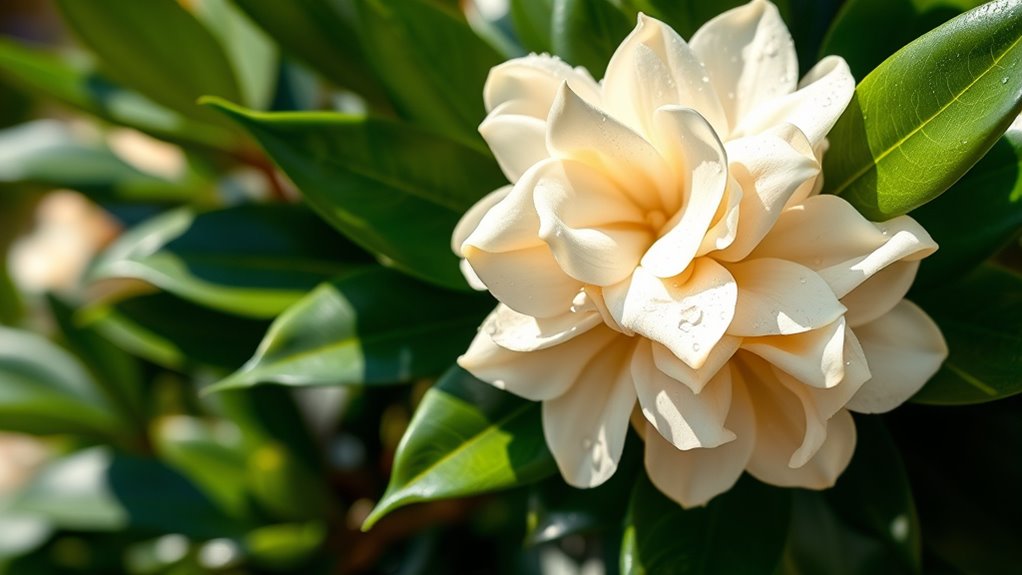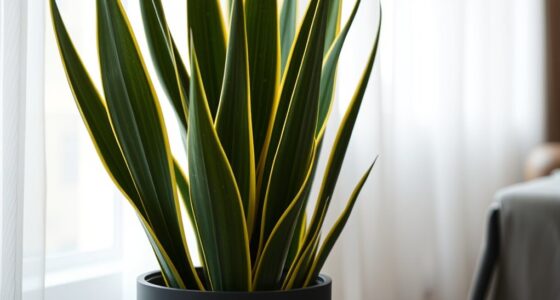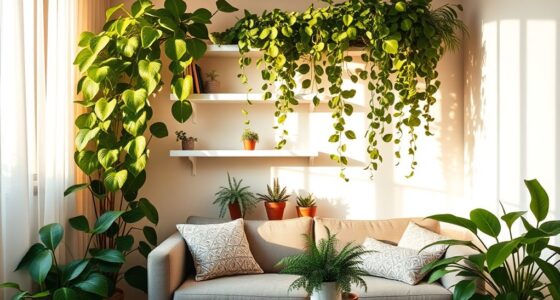To guarantee your gardenia produces fragrant blossoms, focus on maintaining slightly acidic soil with a pH of 5.0–6.0 by testing regularly and amending with peat moss or sulfur if needed. Prune just after flowering to encourage healthy growth, removing dead or damaged stems and spent flowers. Proper care, including soil adjustments and strategic pruning, makes caring for your gardenia easier and more successful—continue exploring for more tips to keep your gardenia lush and fragrant.
Key Takeaways
- Maintain slightly acidic soil pH (5.0–6.0) with organic amendments like peat moss or sulfur for healthy blooms.
- Prune immediately after flowering to promote bushiness and remove dead or damaged stems.
- Regularly test soil pH to ensure optimal nutrient absorption and adjust as needed.
- Avoid pruning in late fall or winter to prevent stress during dormancy.
- Consistently care for moisture, light, and soil conditions to ensure lush, fragrant blossoms year after year.

Are you wondering how to keep your gardenia lush and fragrant? The key lies in understanding its specific needs, especially when it comes to soil pH and pruning techniques. Gardenias thrive in slightly acidic soil, with a pH level around 5.0 to 6.0. If your soil leans too alkaline, the plant won’t absorb essential nutrients properly, leading to weak growth and fewer blooms. To guarantee the right soil conditions, test your soil regularly using a pH tester. If it’s too high, you can amend it by adding organic materials like peat moss or sulfur to lower the pH. Consistently maintaining the correct soil pH creates an ideal environment that promotes healthy roots, vibrant foliage, and those signature fragrant blossoms you love.
Pruning is another essential aspect of gardenia care, but it’s not just about trimming for the sake of shape. Proper pruning techniques help stimulate new growth, improve air circulation, and encourage more flowers. The best time to prune your gardenia is right after it finishes blooming since this prevents removing flower buds that develop the following season. When you prune, use sharp, clean tools to make clean cuts just above a leaf node or lateral branch. Remove any dead, damaged, or diseased stems to keep the plant healthy. Don’t be tempted to over-prune; instead, focus on selectively thinning out crowded areas to allow light and air to reach the inner foliage. This not only helps prevent disease but also promotes vigorous new growth, which in turn leads to more blossoms.
As you prune, remember that gardenias can be sensitive to heavy cuts, so aim for a light hand. Regular maintenance pruning can be as simple as pinching back new growth to encourage bushiness or removing spent flowers to stimulate continued blooming. Be cautious not to prune in late fall or winter, as this can weaken the plant during its dormant period. When done correctly, pruning enhances the overall health and aesthetics of your gardenia, resulting in a more fragrant and visually appealing shrub. Additionally, avoiding excessive heat during pruning can prevent stress to the plant and promote better recovery. Keep in mind that consistent care, including maintaining proper soil pH and employing effective pruning techniques, is the foundation of a thriving gardenia. With patience and attention to these details, you’ll enjoy a lush, fragrant garden filled with beautiful blossoms season after season.
Frequently Asked Questions
How Often Should I Prune My Gardenia?
You should prune your gardenia after it finishes blooming, typically in late summer or early fall, to establish a proper pruning schedule. Regular pruning encourages healthy growth and bloom encouragement. Trim back any dead or overgrown branches to maintain its shape, but avoid heavy pruning that could reduce next season’s flowers. Light pruning every few months keeps the plant vigorous and ensures abundant, fragrant blossoms year after year.
Can Gardenias Thrive Indoors Without Direct Sunlight?
You can grow gardenias indoors without direct sunlight, but you’ll need to make certain of proper indoor humidity and artificial lighting. Place your plant in a bright spot with indirect light, and supplement with grow lights if natural light is limited. Keep the humidity high by misting or using a humidifier, as gardenias thrive in moist environments. Consistent care will help your indoor gardenia flourish without direct sunlight.
What Pests Commonly Affect Gardenias and How to Treat Them?
You’ll want to identify common pests like aphids, spider mites, and whiteflies that affect gardenias. Pest identification helps you choose effective treatments. You can use natural remedies such as neem oil, insecticidal soap, or introducing beneficial insects like ladybugs. Regularly inspect your plant, especially the undersides of leaves, to catch pests early and keep your gardenia healthy and fragrant.
Is It Necessary to Fertilize Gardenias During Winter?
You don’t need to fertilize your gardenia during winter because its growth slows down. Winter fertilization isn’t necessary, as the plant’s nutrition needs decrease when it’s dormant. Instead, focus on maintaining proper watering and protecting it from cold drafts. Once spring arrives, resume regular feeding to support healthy blooms. This approach guarantees your gardenia stays healthy without overfeeding during its winter rest period.
How Can I Prevent Brown Leaf Tips on My Gardenia?
Brown leaf tips can bother your gardenia, but you can beat them by balancing your watering schedule and boosting humidity control. Keep the soil consistently moist but not soggy, and mist the leaves regularly to increase humidity. Avoid overwatering or letting the soil dry out completely. Proper watering and humidity help prevent dehydration, reduce tip browning, and keep your gardenia looking gorgeous and healthy.
Conclusion
With just a little love and attention, your gardenia will reward you with blooms so stunning, they’ll outshine even the most dazzling fireworks. Keep an eye on its needs—water, light, and humidity—and you’ll enjoy its fragrant blossoms all season long. Remember, caring for your gardenia isn’t just rewarding; it’s like nurturing a tiny piece of heaven right in your own home. Stick with these tips, and your gardenia will thrive like a superstar plant!









